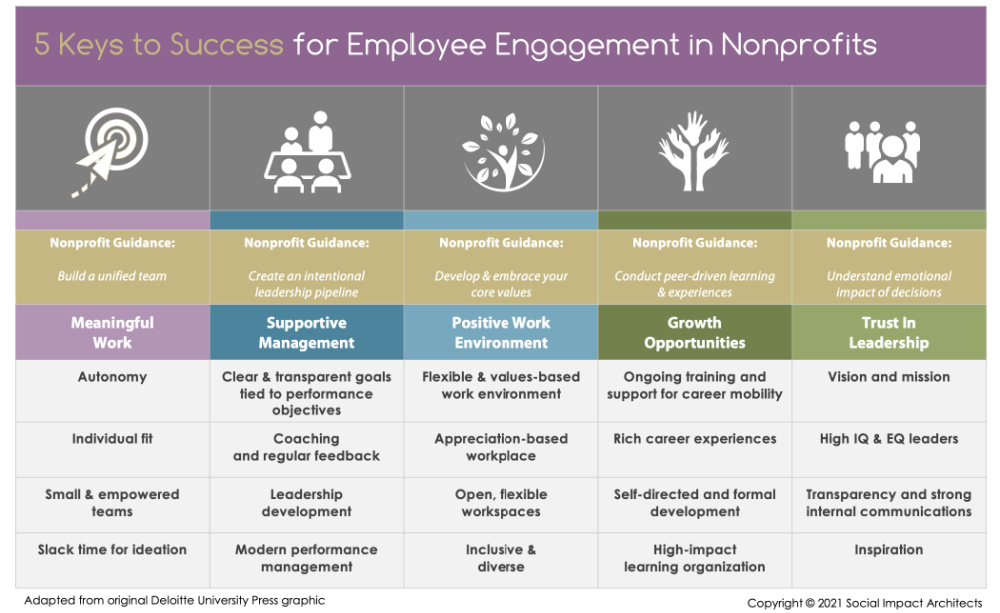 COVID-19 taught us many lessons – one of the most powerful for me was about the importance of organizational culture and employee engagement. Based on our research, we have found a direct correlation between those nonprofits that had a strong internal culture and those that weathered the pandemic successfully. Now is the perfect time to redouble our employee engagement efforts to ensure a productive nonprofit workforce.
COVID-19 taught us many lessons – one of the most powerful for me was about the importance of organizational culture and employee engagement. Based on our research, we have found a direct correlation between those nonprofits that had a strong internal culture and those that weathered the pandemic successfully. Now is the perfect time to redouble our employee engagement efforts to ensure a productive nonprofit workforce. The modern workforce has shifted power from the employer to employees who can apply for new jobs with a simple click. With attrition costing nonprofits and social entrepreneurs at least 20 percent of each employee’s salary in lost productivity, morale and knowledge, keeping our teams energized and invested in our work benefits the social sector and our clients. Employee engagement is less about salary, appreciation or satisfaction scores, and more about employees’ emotional commitment to the organization, its vision and goals and their coworkers.
To kick-start your brainstorming session on how to engage employees at the highest level, we are sharing insights from Deloitte University Press’ Becoming Irresistible: A New Model for Employee Engagement, along with lessons gleaned from our work in the social sector. In our experience, one of the biggest drivers of nonprofit recruitment is passion for the work, but the biggest driver of retention is enjoyment. Inspired by best practices, we have included five keys to boost your social sector organization’s engagement and retention.
Meaningful Work
To keep your team engaged, employees want to know what they do makes a difference to your clients and communities. This can be easier for employees on the frontlines, but harder for those in administrative areas. To bridge this divide and ensure everyone feels they are on a unified team, consider offering annual job shadowing or volunteer rotations and holding mission moments at each staff meeting. Employees also want to be empowered to decide how they will reach goals. It is essential for employees to be included in the strategic planning process through surveys and task forces. This way, they can provide on-the-ground intelligence that will not only inform the plan, but also ensure that action plans and dashboards are realistic and meaningful. Consider giving staff regular opportunities (e.g., comment box, polling/surveys) to provide feedback to the management team to bring fresh ideas to the table.
Supportive Management
Supportive management does not mean micromanaging your team’s every move; it simply means that managers are fully invested in supporting and coaching employees on their paths to achieving their performance goals. It requires providing regular feedback (vs. annual feedback) and building jobs around employees’ strengths. To accomplish this, consider having a competency assessment for each role. When an employee gets a position, have them fill it out and compare their answers to yours – it will spur conversations about expectations and needs. Then, develop a robust professional development plan, including trainings and mentorship, to bolster their strengths and assist with challenges. Revisit this assessment regularly to show progress and add new areas of growth. Nonprofits also should consider an internal leadership pipeline – it supports the organization’s goals around succession planning, but also encourages employees to learn and grow outside their direct area of work. Also keep in mind that it is crucial for frontline employees who move into management roles to receive leadership development so they can properly coach their team to success.
Positive Work Environment
People want flexibility to work individually or in teams as their work demands. They also want to be authentic at work and recognized by (and give recognition to) their superiors and peers for a job well done. Employees differ in the type of recognition they need to feel fulfilled. If you want a fun activity at a retreat or staff meeting, have employees take the online Five Love Languages quiz to find out which “love language” makes the biggest difference to them. Then, use this information to tailor your recognition efforts to their preference. Employees also want to be part of workplaces that value their unique point of view. To accomplish this effectively, you may want to start an EDI (Equity-Diversity-Inclusion) staff task force to make suggestions (and take action) on creating a culture that values diversity and promotes belonging. When these elements are incorporated into your organization’s core values, it sends a strong message to applicants as well as employees about the work environment.
Growth Opportunities
Employees, particularly those under 35, want jobs that push them to grow and acquire new skills. This does not necessarily mean they want a promotion every year. Younger employees desire formal and informal professional development, opportunities to try something new and the chance to grow once they’ve mastered certain skills. If your budget is limited, consider hosting “lunch and learns” where employees lead trainings in areas of expertise or book clubs where you discuss relevant professional books/podcasts connected to collective organizational needs. Our favorites for clients are The Five Choices, Dare to Lead and The Speed of Trust. And, get creative — we have a client who launched an internal Toastmasters to help employees strengthen their presentation skills.
Trust in Leadership
Luckily for the social sector, people want to work at organizations with a purpose, but they also want leaders who are transparent and invest in their development. In the social sector, because employees lead with their heart, decisions are often more personal and emotional, so trust in leadership is essential. To that end, leadership must openly share things like when mistakes occur and how decisions are made. To gauge how you are doing in this area, we recommend an annual survey of employee satisfaction. We suggest using simple quantitative and qualitative questions to get to the heart of this issue and produce measurable results that can be tracked annually. Then, as with every survey, employers need to share the results, celebrate achievements and take steps to improve where needed.
All of this effort really works! Organizations with a highly engaged workforce have been shown to be 30 percent more innovative and 200 percent more effective than ones without an engaged workforce. We need high-functioning teams in the social sector to produce excellence for the communities we serve. If you have low-cost and effective employee engagement ideas, we hope you will share them with us.


Just like the words we sing in a song,
Positive social skills move us along.
Friendship and Teamwork help make us a fit,
So all our employees say “I CAN DO IT”.
Hehehe…check out our song I CAN DO IT here https://soundcloud.com/growing-sound/i-can-do-it